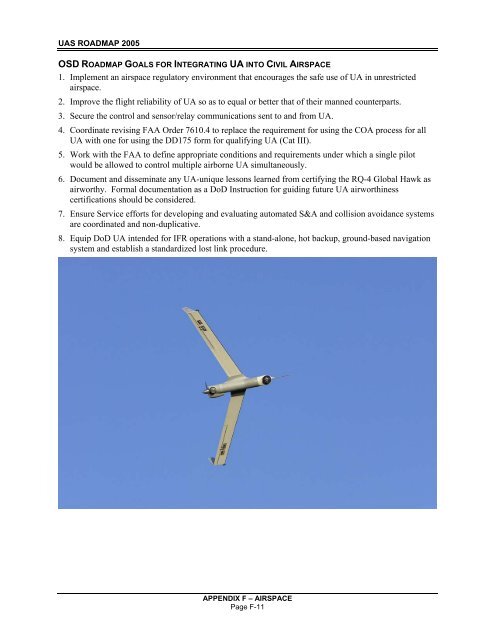Unmanned Aircraft Systems Roadmap 2005-2030 - Federation of ...
Unmanned Aircraft Systems Roadmap 2005-2030 - Federation of ... Unmanned Aircraft Systems Roadmap 2005-2030 - Federation of ...
UAS ROADMAP 2005 OSD ROADMAP GOALS FOR INTEGRATING UA INTO CIVIL AIRSPACE 1. Implement an airspace regulatory environment that encourages the safe use of UA in unrestricted airspace. 2. Improve the flight reliability of UA so as to equal or better that of their manned counterparts. 3. Secure the control and sensor/relay communications sent to and from UA. 4. Coordinate revising FAA Order 7610.4 to replace the requirement for using the COA process for all UA with one for using the DD175 form for qualifying UA (Cat III). 5. Work with the FAA to define appropriate conditions and requirements under which a single pilot would be allowed to control multiple airborne UA simultaneously. 6. Document and disseminate any UA-unique lessons learned from certifying the RQ-4 Global Hawk as airworthy. Formal documentation as a DoD Instruction for guiding future UA airworthiness certifications should be considered. 7. Ensure Service efforts for developing and evaluating automated S&A and collision avoidance systems are coordinated and non-duplicative. 8. Equip DoD UA intended for IFR operations with a stand-alone, hot backup, ground-based navigation system and establish a standardized lost link procedure. APPENDIX F – AIRSPACE Page F-11
UAS ROADMAP 2005
- Page 128 and 129: UAS ROADMAP 2005 � Aircraft Contr
- Page 130 and 131: UAS ROADMAP 2005 � Any new federa
- Page 132 and 133: UAS ROADMAP 2005 communications, pr
- Page 134 and 135: UAS ROADMAP 2005 CDL requirements e
- Page 136 and 137: UAS ROADMAP 2005 decryption and enc
- Page 138 and 139: UAS ROADMAP 2005 APPENDIX D: TECHNO
- Page 140 and 141: UAS ROADMAP 2005 specific fuel cons
- Page 142 and 143: UAS ROADMAP 2005 technology program
- Page 144 and 145: UAS ROADMAP 2005 the effect of smal
- Page 146 and 147: UAS ROADMAP 2005 Displays that show
- Page 148 and 149: UAS ROADMAP 2005 29 % ($747.3 M) in
- Page 150 and 151: UAS ROADMAP 2005 Laboratory Initiat
- Page 152 and 153: UAS ROADMAP 2005 APPENDIX E: INTERO
- Page 154 and 155: UAS ROADMAP 2005 layer 4 protocol i
- Page 156 and 157: UAS ROADMAP 2005 The family of stan
- Page 158 and 159: UAS ROADMAP 2005 Military Satellite
- Page 160 and 161: UAS ROADMAP 2005 DoD Discovery Meta
- Page 162 and 163: UAS ROADMAP 2005 STANAG 3809 (Digit
- Page 164 and 165: UAS ROADMAP 2005 � SDN.706, X.509
- Page 166 and 167: UAS ROADMAP 2005 Level 1: Indirect
- Page 168 and 169: UAS ROADMAP 2005 APPENDIX F: AIRSPA
- Page 170 and 171: UAS ROADMAP 2005 Class A or B Misha
- Page 172 and 173: UAS ROADMAP 2005 Hawk and Predator,
- Page 174 and 175: UAS ROADMAP 2005 knowledge skills r
- Page 176 and 177: UAS ROADMAP 2005 decision and the a
- Page 180 and 181: UAS ROADMAP 2005 APPENDIX G: TASK,
- Page 182 and 183: UAS ROADMAP 2005 APPENDIX H: RELIAB
- Page 184 and 185: UAS ROADMAP 2005 throughout its ACT
- Page 186 and 187: UAS ROADMAP 2005 17% 14% 12% 19% 38
- Page 188 and 189: UAS ROADMAP 2005 that for a number
- Page 190 and 191: UAS ROADMAP 2005 RECOMMENDATIONS Ba
- Page 192 and 193: UAS ROADMAP 2005 APPENDIX I: HOMELA
- Page 194 and 195: UAS ROADMAP 2005 CUSTOMS AND BORDER
- Page 196 and 197: UAS ROADMAP 2005 APPENDIX J: UNMANN
- Page 198 and 199: UAS ROADMAP 2005 Joint Robotics Pro
- Page 200 and 201: UAS ROADMAP 2005 Anti-Personnel/Obs
- Page 202 and 203: UAS ROADMAP 2005 The UGV family wil
- Page 204 and 205: UAS ROADMAP 2005 In Phase I, an exp
- Page 206 and 207: UAS ROADMAP 2005 is NSWC Panama Cit
- Page 208 and 209: UAS ROADMAP 2005 APPENDIX K: SURVIV
- Page 210 and 211: UAS ROADMAP 2005 such as flares, ch
- Page 212 and 213: UAS ROADMAP 2005 TABLE K-1. SURVIVA
UAS ROADMAP <strong>2005</strong><br />
OSD ROADMAP GOALS FOR INTEGRATING UA INTO CIVIL AIRSPACE<br />
1. Implement an airspace regulatory environment that encourages the safe use <strong>of</strong> UA in unrestricted<br />
airspace.<br />
2. Improve the flight reliability <strong>of</strong> UA so as to equal or better that <strong>of</strong> their manned counterparts.<br />
3. Secure the control and sensor/relay communications sent to and from UA.<br />
4. Coordinate revising FAA Order 7610.4 to replace the requirement for using the COA process for all<br />
UA with one for using the DD175 form for qualifying UA (Cat III).<br />
5. Work with the FAA to define appropriate conditions and requirements under which a single pilot<br />
would be allowed to control multiple airborne UA simultaneously.<br />
6. Document and disseminate any UA-unique lessons learned from certifying the RQ-4 Global Hawk as<br />
airworthy. Formal documentation as a DoD Instruction for guiding future UA airworthiness<br />
certifications should be considered.<br />
7. Ensure Service efforts for developing and evaluating automated S&A and collision avoidance systems<br />
are coordinated and non-duplicative.<br />
8. Equip DoD UA intended for IFR operations with a stand-alone, hot backup, ground-based navigation<br />
system and establish a standardized lost link procedure.<br />
APPENDIX F – AIRSPACE<br />
Page F-11



